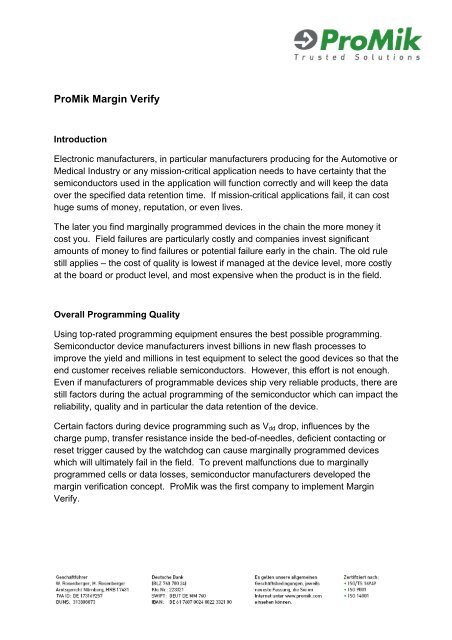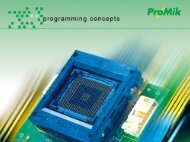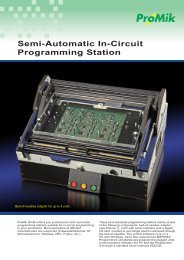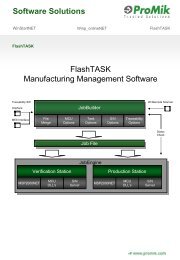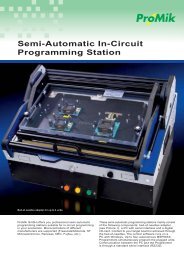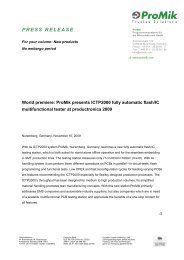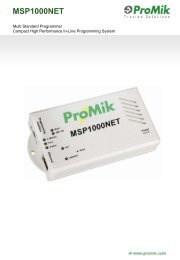Download PDF - ProMik
Download PDF - ProMik
Download PDF - ProMik
Create successful ePaper yourself
Turn your PDF publications into a flip-book with our unique Google optimized e-Paper software.
<strong>ProMik</strong> Margin Verify<br />
Introduction<br />
Electronic manufacturers, in particular manufacturers producing for the Automotive or<br />
Medical Industry or any mission-critical application needs to have certainty that the<br />
semiconductors used in the application will function correctly and will keep the data<br />
over the specified data retention time. If mission-critical applications fail, it can cost<br />
huge sums of money, reputation, or even lives.<br />
The later you find marginally programmed devices in the chain the more money it<br />
cost you. Field failures are particularly costly and companies invest significant<br />
amounts of money to find failures or potential failure early in the chain. The old rule<br />
still applies – the cost of quality is lowest if managed at the device level, more costly<br />
at the board or product level, and most expensive when the product is in the field.<br />
Overall Programming Quality<br />
Using top-rated programming equipment ensures the best possible programming.<br />
Semiconductor device manufacturers invest billions in new flash processes to<br />
improve the yield and millions in test equipment to select the good devices so that the<br />
end customer receives reliable semiconductors. However, this effort is not enough.<br />
Even if manufacturers of programmable devices ship very reliable products, there are<br />
still factors during the actual programming of the semiconductor which can impact the<br />
reliability, quality and in particular the data retention of the device.<br />
Certain factors during device programming such as Vdd drop, influences by the<br />
charge pump, transfer resistance inside the bed-of-needles, deficient contacting or<br />
reset trigger caused by the watchdog can cause marginally programmed devices<br />
which will ultimately fail in the field. To prevent malfunctions due to marginally<br />
programmed cells or data losses, semiconductor manufacturers developed the<br />
margin verification concept. <strong>ProMik</strong> was the first company to implement Margin<br />
Verify.
Margin Verify<br />
Margin Verify has only one purpose: To ensure that the charge in each cell is at a<br />
proper level and not near the margin. Once verified that the correct charge is at the<br />
correct level in each cell, the electronic manufacturer knows that the product will work<br />
properly over the specified data retention time period.<br />
In our example a fully erased cell equals the value “1”, charged cell equals the value<br />
“0”. It is recommended to always erase the device before programming to get to a<br />
known, defined stage.<br />
If the cell has been erased to a “1” value, the device should internally measure the current<br />
level as shown. If the cell has been programmed to a “0” value the device should<br />
internally measure a current level in the color as shown. Sometimes the current measured<br />
in a cell does not fall perfectly into the “1” region or the “0” region. Instead, it falls<br />
somewhere in between and the device will read it either at a “0” or at a “1”. Thus the<br />
purpose of the cell margin verification is to eliminate false positives and false negatives.<br />
The Verify in normal read mode performed after programming does not catch this<br />
failure. This Verify is at the data level and compares the data content of<br />
programming file with the data content of the memory space of the device but does<br />
not test the quality of the programming.
With <strong>ProMik</strong>’s Margin Verify the device essentially moves the threshold to decide<br />
whether a cell is a “0” or a “1” closer to the ideal region. This usually involves a twostep<br />
process. First step, the device will move the compare level closer to the “0”<br />
region, then anything with current above the new threshold level will be considered a<br />
“1”. Anything below it will be considered a “0”. In the next step the devices moves the<br />
threshold closer to the “1” region and the process is repeated.<br />
Summary<br />
<strong>ProMik</strong>’s cell margin verification fully tests the quality of programming to ensure<br />
maximum data retention. <strong>ProMik</strong>’s Programming Service programs every year<br />
millions of parts has demonstrated a 0 PPM failure rate. Automotive companies or<br />
any mission-critical application should always ask for the Margin Verify to ensure<br />
perfect data retention for their application. And they should always choose a<br />
programming company that provides the best possible Margin Verify. This feature will<br />
reduce product failures resulting from component failure and from improper<br />
programming.


